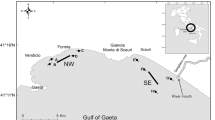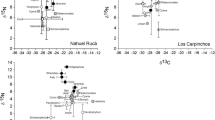Abstract
Bottom-feeding fish show great variation in trophic morphology, resulting in a wide array of feeding habits exploiting from periphyton in littoral habitats to ingesting larger amounts of litterfall from terrestrial habitats. Nevertheless, it has been proposed that, in temperate aquatic systems, the energetic demands from bottom-feeding fish are supplied by primary production from phytoplankton in pelagic habitats. Thus, we aimed to determine which of several energy sources support bottom-feeding fish in tropical aquatic systems, where primary producers are diverse. We performed samplings in the Paraná River floodplain from primary producers in littoral (periphyton), pelagic (phytoplankton) and terrestrial habitats (riparian vegetation). Using simultaneous signatures of C and N isotope ratios, we analysed the possible origin of available energy in muscles of nine different bottom-feeding fish species. We verified that seven of the nine fish species had the highest contribution of carbon from a littoral source compared to other energy sources, independent of trophic category. The importance of periphyton may be related to the high abundance of substrates (such as macrophytes) that are available in the littoral zone of tropical aquatic systems. Finally, we suggest that the actual carbon dynamics among bottom-feeding fish and primary producers is species-specific, varying within the same trophic guild, and therefore, it is possible to refute the assumption that each trophic guild is specialised for a distinct carbon source.



Similar content being viewed by others
References
Agostinho AA, Hahn NS, Gomes LC, Bini LM (1997) Estrutura trófica. In: Vazzoler AEAM, Agostinho AA, Hahn NS (eds) A planície de inundação do alto rio Paraná: aspectos físicos, biológicos e socioeconômicos. EDUEM, Maringá, pp 209–228
Araújo-Lima CARM, Forsberg BR, Victoria R, Martinelli LA (1986) Energy sources for detritivorous fishes in the Amazon. Science 234:1256–1258
Benedito-Cecilio E, Araújo-Lima CARM (2002) Variation in the carbon isotope composition of Semaprochilodus insignis, a detritivorous fish associated with oligotrophic and eutrophic Amazon rivers. J Fish Biol 60:1603–1607
Benedito-Cecilio E, Forsberg BR, Bittencourt MM, Martinelli LA (2000) Carbon sources of Amazonian fisheries. Fish Manag Ecol 7:305–315
Botto F, Gaitán E, Mianzan H, Acha M, Gilberto D, Schiariti A, Iribarne O (2011) Origin of resources and trophic pathways in a large SW Atlantic estuary: An evaluation using stable isotopes. Estuar Coast Shelf Sci 92:70–77
Bowen SH (1983) Detritivory in neotropical fish communities. Environ Biol Fish 9:137–144
Campos JB, Souza MC (1997) Vegetação. In: Vazzoler AEAM, Agostinho AA, Hahn NS (eds) A planície de inundação do alto rio Paraná: aspectos físicos, biológicos e socioeconômicos. EDUEM, Maringá, pp 331–342
Casatti L, Mendes HF, Ferreira KM (2003) Aquatic macrophytes as feeding site for small fishes in the Rosana Reservoir, Paranapanema River, Southeastern Brazil. Braz J Biol 63:213–222
Chandra S, Vander Zanden MJ, Heyvaert AC, Richards BC, Allen BC, Goldman CR (2005) The effects of cultural eutrophication on the coupling between pelagic primary producers and benthic consumers. Limnol Oceanogr 50:1368–1376
Fugi R, Hahn NS, Agostinho AA (1996) Feeding styles of five species of bottom-feeding fishes of the high Paraná River. Environ Biol Fish 46:297–307
Fugi R, Agostinho AA, Hahn NS (2001) Trophic morphology of five benthic-feeding fish species of a tropical floodplain. Braz J Biol 61:27–33
Gerking SD (1994) Feeding ecology of fish. Academic, San Diego
Gorman OT, Yule DL, Stockwell JD (2012) Habitat use by fishes of Lake Superior. II. Consequences of diel habitat use for habitat linkages and habitat coupling in nearshore and offshore waters. Aquat Ecosyst Health Manag 15:354–367
Hamilton SK, Lewis WM Jr (1992) Stable carbon and nitrogen isotopes in algae and detritus from the Orinoco River floodplain, Venezuela. Geochim Cosmochim Acta 56:4237–4246
Jones JI, Sayer CD (2003) Does the fish–invertebrate–periphyton cascade precipitate plant loss in shallow lakes? Ecology 84:2155–2167
Krumhansl KA, Scheibling RE (2011) Detrital production in Nova Scotian kelp beds: patterns and processes. Mar Ecol Prog Ser 421:67–82
Lopes CA, Benedito-Cecilio E, Martinelli LA, Souza MC (2006) Variability of 13C and 15 N in terrestrial and aquatic sources in the upper Paraná river basin, Paraná, Brazil. Acta Limnol Bras 18:281–292
Lopes CA, Benedito-Cecilio E, Martinelli LA (2007) Variability in the carbon isotope signature of Prochilodus lineatus (Prochilodontidae, Characiformes) a bottom-feeding fish of the Neotropical region. J Fish Biol 70:1649–1659
Lövgren J, Persson L (2002) Fish-mediated indirect effects in a littoral food web. Oikos 96:150–156
Luek A, Morgan GE, Wissel B, Gunn JM, Ramcharan CW (2013) Impaired littoral energy pathways cause a shift to pelagic resources by fish in recovering lake food webs. Ecol Freshw Fish 22:348–360
McCutchan JH Jr, Lewis WM Jr, Kendall C, McGrath CC (2003) Variation in trophic shift for stable isotope ratios of carbon, nitrogen, and sulfur. Oikos 102:378–390
Michener RH, Lajtha K (2007) Stable isotopes in ecology and environmental science. Blackwell Scientific Publications, Oxford
Parnell A, Inger R, Bearhop S, Jackson AL (2008) SIAR: Stable Isotope Analysis in R. <http://cran.r-project.org/web/packages/siar>.
Parnell A, Inger R, Bearhop S, Jackson AL (2010) Source partitioning using stable isotopes: coping with too much variation. PLoS One 5:e9672
Quevedo M, Svanback R, Eklov P (2009) Intrapopulation niche partitioning in a generalist predator limits food web connectivity. Ecology 90:2263–2274
Ruitton S, Francour P, Boudouresque CF (2000) Relationships between algae, benthic herbivorous invertebrates and fishes in rocky sublittoral communities of a Temperate Sea (Mediterranean). Estuar Coast Shelf Sci 50:217–230
Schindler DE, Scheuerell MD (2002) Habitat coupling in lake ecosystems. Oikos 98:177–189
Sierszen ME, Peterson GS, Scharold JV (2006) Depth specific patterns in benthic–planktonic foodweb relationships relationships in Lake Superior. Can J Fish Aquat Sci 63:1496–1503
Thomaz SM, Dibble ED, Evangelista LR, Higuti J, Bini LM (2008) Influence of aquatic macrophyte habitat complexity on invertebrate abundance and richness in tropical lagoons. Freshw Biol 53:358–367
Torres IC, Inglett PW, Brenner M, Kenney WF, Reddy KR (2012) Stable isotope (δ13C and δ15N) values of sediment organic matter in subtropical lakes of different trophic status. J Paleolimnol 47:693–706
Vadeboncoeur Y, Jeppesen E, Vander Zanden MJ, Schierup HH, Christoffersen K, Lodge DM (2003) From Greenland to green lakes: Cultural eutrophication and the loss of benthic pathways in lakes. Limnol Oceanogr 48:1408–1418
Vander Zanden MJ, Vadeboncoeur Y (2002) Fishes as integrators of benthic and pelagic foodwebs in lakes. Ecology 83:2152–2161
Vander Zanden MJ, Cabana G, Rasmussem JB (1997) Comparing trophic position of freshwater fish calculated using stable nitrogen isotope ratios (δ15N) and literature dietary data. Can J Fish Aquat Sci 54:1142–1158
West JB, Bowen GJ, Cerling TE, Ehleringer JR (2006) Stable isotopes as one of nature′s ecological recorders. Trends Ecol Evol 21:408–414
Yossa MI, Araújo-Lima CARM (1998) Detritivory in two Amazonian fish species. J Fish Biol 52:1141–1153
Acknowledgments
We thank Brazilian National Agency for Scientific and Technological Development (CNPq) for its financial support. We also thank PELD (UEM-NUPELIA) field teams for their help in collecting the biological material and the laboratories of Zoology (DBI), Zooplankton, Phytoplankton, Periphyton, Riparian Vegetation, Limnology, and Zoobenthos (NUPELIA) for their logistical support. All authors are grateful to Maria S. R. Arita and João F. Hildebrant for help with bibliographical material. Finally, we thank Roger P. Mormul for critically reading this manuscript. The present research was conducted in agreement with the “Ethical Principles in Animal Research” adopted by the Brazilian College of Animal Experimentation (COBEA).
Author information
Authors and Affiliations
Corresponding author
Rights and permissions
About this article
Cite this article
Lopes, C.A., Manetta, G.I., Figueiredo, B.R.S. et al. Carbon from littoral producers is the major source of energy for bottom-feeding fish in a tropical floodplain. Environ Biol Fish 98, 1081–1088 (2015). https://doi.org/10.1007/s10641-014-0343-7
Received:
Accepted:
Published:
Issue Date:
DOI: https://doi.org/10.1007/s10641-014-0343-7




